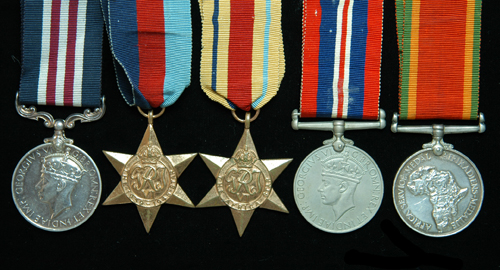
Auction: 7012 - Orders, Decorations, Medals & Militaria
Lot: 600
The Second War ´Immediate´ Western Desert Sidi Rezegh M.M. Group of Five to Private R.J. Roberts, South African Army Medical Corps a) Military Medal, G.VI.R. (116107 Pte, R.J, Roberts. S.A.M.C.) b) 1939-1945 Star c) Africa Star d) War Medal e) Africa Service Medal, the campaign medals all officially named (116107 R.J. Roberts); stars gilded, generally very fine or better (5) Estimate £ 700-800 M.M. London Gazette 24.2.1942 116107 Pte. R.J. Roberts 11 S.A. Fd. Amb. Roberts was initially recommended for a D.C.M., however was subsequently downgraded to a M.M. The Recommendation states ´Sidi Rezegh Battle 23. Nov 41. While under intense artillery fire he continued to drive his ambulance and pick up wounded on the battle-field at Sidi Rezegh on 23 Nov 41. He did many trips during the day under these conditions even though his ambulance was being badly "shot up". By his action he brought many wounded quickly to medical aid. Finally his ambulance received a direct hit and was destroyed.´ 116107 Private Rowland John Roberts, M.M., born Ladysmith, South Africa, 1915; enlisted with the South African Union Defence Force, 1.5.1940 and served during the Second War in East Africa, Abyssinia and the Middle East including with the 11th South African Field Ambulance under Major L. Melzer at the Battle of Sidi Rezegh, 23.11.1941, ´Major Melzer was in command of an MDS supporting the advance of 5th South African Infantry Brigade during the Crusader battles of November-December 1941. The brigade was virtually wiped out as a fighting entity and casualties were heavy. The fighting was also extremely confused and the MDS was regularly bypassed by German, Italian and British columns as the battle raged around them. Melzer´s report on the activities of his MDS noted one potentially disastrous episode: ´At about 1300 hours on 23 November the burial of twenty bodies was about to begin. The medical officers and orderlies were all working at full pressure, and I had just completed a plaster cast. Suddenly, the tank battle started. As no slits had been dug for the casualties who had been coming in all day, we all lay on tarpaulins. I was able to see the entire battle which started on the left of B echelon, the British tanks being about 400 yards to the west of the MDS. As the battle progressed they were gradually pushed back, closer and closer to us. Eventually they reached us, and our tanks actually worked their way between the groups of casualties lying on the ground. By this time the German tanks could be seen on the horizon, the MDS lying between the German and British tanks and the German tanks coming nearer. They eventually reached us. My greatest concern was whether they would show the same consideration the British did, and not drive their tanks over the casualties. My fears, however were quite unfounded because the German tanks kept clear of the persons lying on the ground, and not one of the casualties or personnel was run over by a tank. Soon after, their infantry and recovery vehicles arrived and we were all taken prisoner.´ (The Imperial War Museum Book of the Desert War 1940-42, refers). For the next three days Melzer and his M.D.S. worked under AXIS control treating wounded from both sides, before being liberated by New Zealand troops; Roberts was invalided out of the Army, 30.8.1943.
Sold for
£1,300




